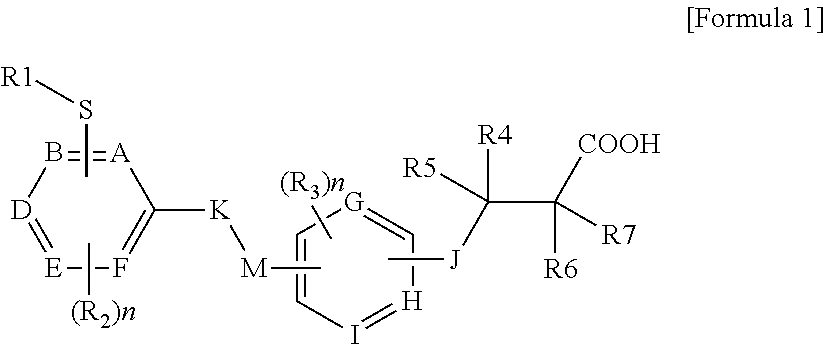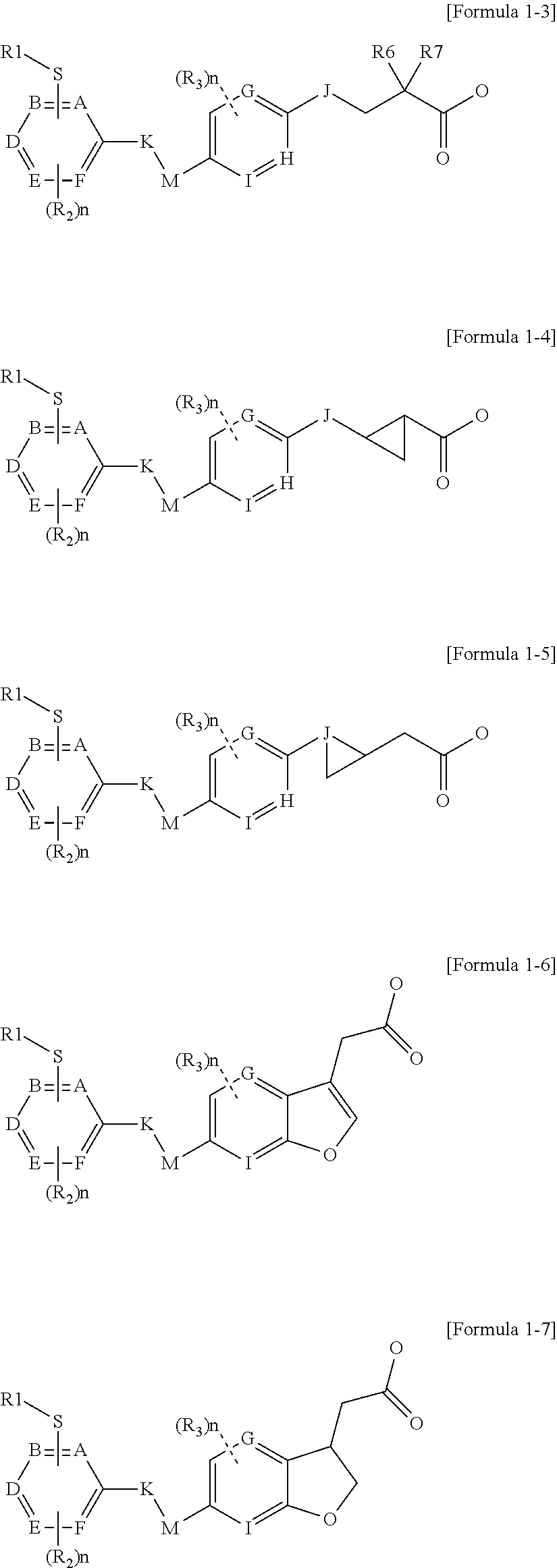Thioaryl derivatives as gpr120 agonists
- Summary
- Abstract
- Description
- Claims
- Application Information
AI Technical Summary
Benefits of technology
Problems solved by technology
Method used
Image
Examples
preparation example 1
3-chloromethyl-2-isopropylsulfanyl-pyridine
Step A: 2-isopropylsulfanyl-nicotinic acid
[0295]2-Mercapto-nicotinic acid (5.0 g, 32.22 mmol) was dissolved in DMF (40 mL), and the solution was cooled to 0˜5° C. NaH (6.4 g, 161.1 mmol) was added thereto slowly, and the mixture was stirred at 0˜5° C. for 30 minutes. 2-Iodo-propane (9.65 mL, 96.66 mmol) was added thereto, and the mixture was stirred at room temperature for 2 hours. After the termination of the reaction, the reactant was concentrated under reduced pressure and water was added to dilute the residue. 3N HCl was added to adjust the pH of the aqueous solution to 2˜3, and the mixture was extracted with EtOAc. The organic layer was dried with MgSO4 and concentrated under reduced pressure. The reaction product was used in the next step without a separate purification process.
[0296]1H-NMR (DMSO-d6) δ 8.57 (1H, m), 8.12 (1H, m), 7.16 (1H, m), 3.96 (1H, m), 1.28 (6H, d)
Step B: (2-isopropylsulfanyl-pyridin-3-yl)-methanol
[0297]2-Isoprop...
preparation example 2
3-(3,5-difluoro-4-hydroxy-phenyl)-propionic acid ethyl ester
Step A: 3,5-difluoro-4-hydroxy-benzaldehyde
[0301]TFA (7 mL) was added to 2,6-difluoro-phenol (1.0 g, 7.69 mmol) and hexam-ethylenetetraamine (1.08 g, 7.69 mmol), and the mixture was stirred at 75˜80° C. for 12 hours. The reactant was cooled, diluted with water, and then extracted with DCM / MeOH (9:1) solution three or four times. The organic layer was concentrated under reduced pressure, and DCM was added to the residue. The mixture was dried with MgSO4 and concentrated under reduced pressure. The reaction product was used in the next step without a separate purification process.
Step B: 4-benzyloxy-3,5-difluoro-benzaldehyde
[0302]3,5-Difluoro-4-hydroxy-benzaldehyde obtained in Step A was dissolved in CH3CN (15 mL), and Cs2CO3 (6.3 g, 19.23 mmol) was added to the solution. The mixture was cooled to 0˜5° C. Benzylbromide (1.1 mL, 9.23 mmol) was added slowly thereto, and the mixture was stirred at room temperature for 2 hours. A...
preparation example 3
3-(4-hydroxy-phenyl)-2-methyl-propionic acid ethyl ester
Step A: (E)-3-(4-benzyloxy-phenyl)-2-methyl-acrylic acid ethyl ester
[0308]Carbethoxyethylidene triphenylphosphorane (1.02 g, 2.81 mmol) was dissolved in anhydrous THF (25 mL), and 4-benzyloxy-benzaldehyde (0.5 g, 2.36 mmol) / THF (10 mL) solution was added dropwise thereto at −78° C. The mixture was heated slowly to room temperature and then stirred for 12 hours. After the termination of the reaction, the reactant was concentrated under reduced pressure. The residue was added with water and then extracted with EtOAc. The organic layer was dried with MgSO4 and purified by column chromatography (eluent, EtOAc / Hex=1 / 9) to obtain the title compound (0.68 g, 97.4%).
[0309]1H NMR (400 MHz, CDCl3) δ 1.28 and 1.34 (2t, 3H), 2.05 and 2.13 (2s, 3H), 4.18-4.30 (2q, 2H), 5.10 (s, 2H), 6.97-7.02 (m, 2H), 7.31-7.45 (m, 7H), 7.64 (br. s, 1H)
Step B: 3-(4-hydroxy-phenyl)-2-methyl-propionic acid ethyl ester
[0310](E)-3-(4-Benzyloxy-phenyl)-2-methyl-...
PUM
| Property | Measurement | Unit |
|---|---|---|
| Level | aaaaa | aaaaa |
Abstract
Description
Claims
Application Information
 Login to View More
Login to View More - R&D
- Intellectual Property
- Life Sciences
- Materials
- Tech Scout
- Unparalleled Data Quality
- Higher Quality Content
- 60% Fewer Hallucinations
Browse by: Latest US Patents, China's latest patents, Technical Efficacy Thesaurus, Application Domain, Technology Topic, Popular Technical Reports.
© 2025 PatSnap. All rights reserved.Legal|Privacy policy|Modern Slavery Act Transparency Statement|Sitemap|About US| Contact US: help@patsnap.com



